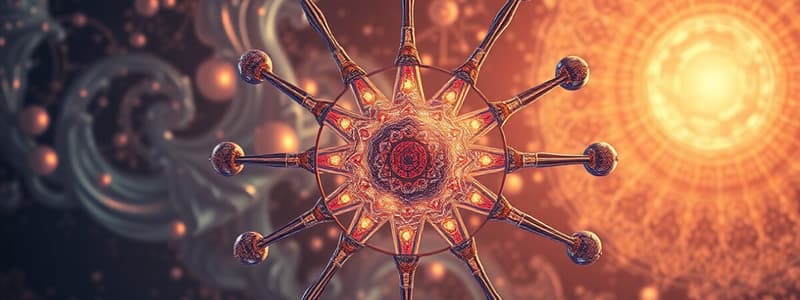Podcast
Questions and Answers
What distinguishes isotopes of an element from one another?
What distinguishes isotopes of an element from one another?
- Different numbers of neutrons (correct)
- Different atomic numbers
- Different numbers of protons
- Different electron configurations
What does the atomic number (Z) represent in an atom?
What does the atomic number (Z) represent in an atom?
- The total number of neutrons
- The number of protons in an atom's nucleus (correct)
- The average atomic mass of an element
- The sum of protons and neutrons
How does a mass spectrometer separate ions?
How does a mass spectrometer separate ions?
- By their total mass
- Based on their electrical charge only
- By their thermal conductivity
- According to their mass-to-charge ratio (correct)
What is the formula to calculate the number of neutrons in an atom?
What is the formula to calculate the number of neutrons in an atom?
What aspects can a mass spectrometer analyze?
What aspects can a mass spectrometer analyze?
Flashcards
Isotopes
Isotopes
Atoms of the same element that have the same number of protons but different numbers of neutrons.
Atomic Number (Z)
Atomic Number (Z)
The number of protons in an atom's nucleus.
Mass Number (A)
Mass Number (A)
The sum of protons and neutrons in an atom's nucleus.
Mass Spectrometer
Mass Spectrometer
Signup and view all the flashcards
Calculating Neutrons
Calculating Neutrons
Signup and view all the flashcards
Study Notes
Atomic Structure and Isotopes
- Atoms consist of a nucleus (containing protons and neutrons) and electrons orbiting the nucleus.
- Atomic number (Z) = number of protons in the nucleus.
- Mass number (A) = number of protons + number of neutrons.
- Isotopes are atoms of the same element with the same number of protons but different numbers of neutrons. They have the same atomic number but different mass numbers.
- The number of electrons equals the number of protons in a neutral atom.
- Calculating the number of neutrons: Number of neutrons = Mass number (A) - Atomic number (Z).
- Isotopes have identical chemical properties due to the same number of electrons and thus the same electron configuration, which influences their interactions in chemical reactions. However, isotopes exhibit different physical properties (e.g., density, diffusion rate) due to their differing masses.
Elements and Atomic Structure Table
- A table displays elements with their atomic numbers (Z), mass numbers (A), and corresponding symbols and names.
- Examples of elements, including Hydrogen (H), Helium (He), Lithium (Li), Beryllium (Be), Carbon (C), Oxygen (O), Sodium (Na), Calcium (Ca), Gold (Au), and Uranium (U), are shown.
- The table shows the corresponding values for A and Z for each element.
Studying That Suits You
Use AI to generate personalized quizzes and flashcards to suit your learning preferences.
Description
Test your knowledge on atomic structure and isotopes with this quiz. It covers concepts such as the nucleus, atomic and mass numbers, and the definition of isotopes. Understand how isotopes vary in physical properties while sharing chemical properties.



